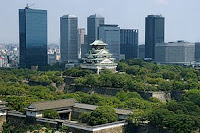
Osaka is famous for cultural Kuidaore (eat much as you like), which continues to eat and not eat solid food again and fell back. Okonomiyaki Osaka is the typical food (fried cabbage with slices of egg contents topping pork or seafood) Takoyaki (fried octopus content of flour round), and Kushikatsu (puncture vegetables or meat wrapped in bread crumbs and fried). Okonomiyaki, Takoyaki, and Udon (noodles from wheat flour) is an example of cultural Konamono (food from wheat flour) is a popular man in Osaka.
Awa-okoshi (sweet puffed rice) and konbu (dried seaweed) is a by-the typical Osaka. For the people of Osaka and also for people who live in western Japan, the word "meat" (niku) without explaining its kind, means beef. In Osaka, if not previously noted, generally means Sukiyaki Beef Sukiyaki.
Osaka man renowned as a brilliant businessman. Once a year during the festival held Tooka Ebisu (9, 10, January 11), merchants and business owners in Osaka will not miss the opportunity to visit the shrine Ebisu smoothly in their business. Ebisu's most famous temple in Osaka is Imamiya-Ebisu, located near the mall Namba Parks.
In addition to trade smart, people in Osaka are also careful shopping. Middle-aged woman from Osaka (Osaka no Obasan) is the stereotype of middle-aged women of Osaka residents who nag, complain, and persistent bid up the price of goods as cheaply as possible. Osaka people generally like to be frank, open and more humor than the Japanese people in general. Disclosure is beneficial Osaka as an international trading center.
-image1362371%5B2%5D.jpg) Osaka man who makes the humor more Osaka as a city that produces best-selling comedian Manzai-comedian who later moved to Tokyo and became a television presenter. Performing comedy kigeki Yoshimoto Shin-Osaka is famous original entertainment throughout Japan.
Osaka man who makes the humor more Osaka as a city that produces best-selling comedian Manzai-comedian who later moved to Tokyo and became a television presenter. Performing comedy kigeki Yoshimoto Shin-Osaka is famous original entertainment throughout Japan.Osaka is also a city friendly to bicyclists. All over the city can be reached by bicycle, although the bikes are parked haphazardly into a problem for city government.
Striking differences between Osaka with other cities in Japan is the place standing on the stairs walking. In Osaka, the user must walk up stairs on the right, while the left is the path to precede. Osaka people can quickly be identified from the side where the stand while climbing stairs to walk. Habit of standing on the right side of the stairs walk starting from the Expo '70 World Exposition held in Osaka.















